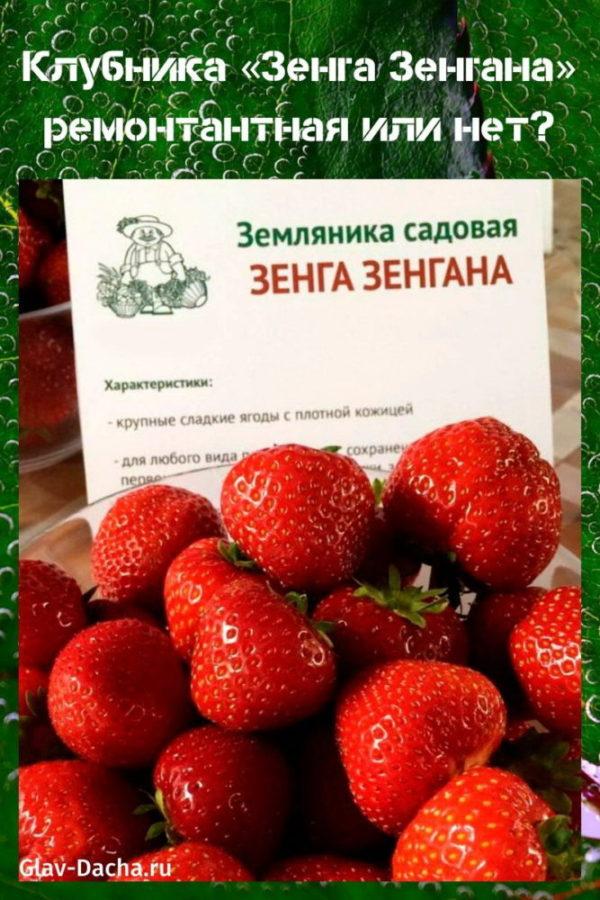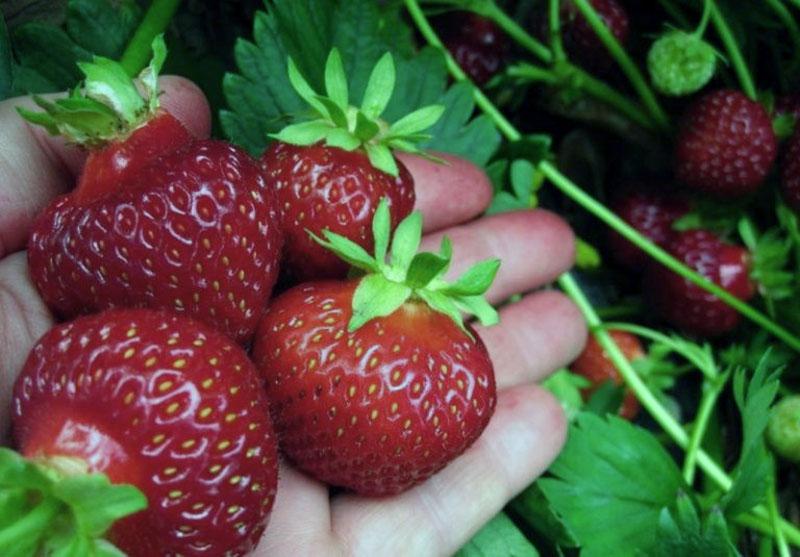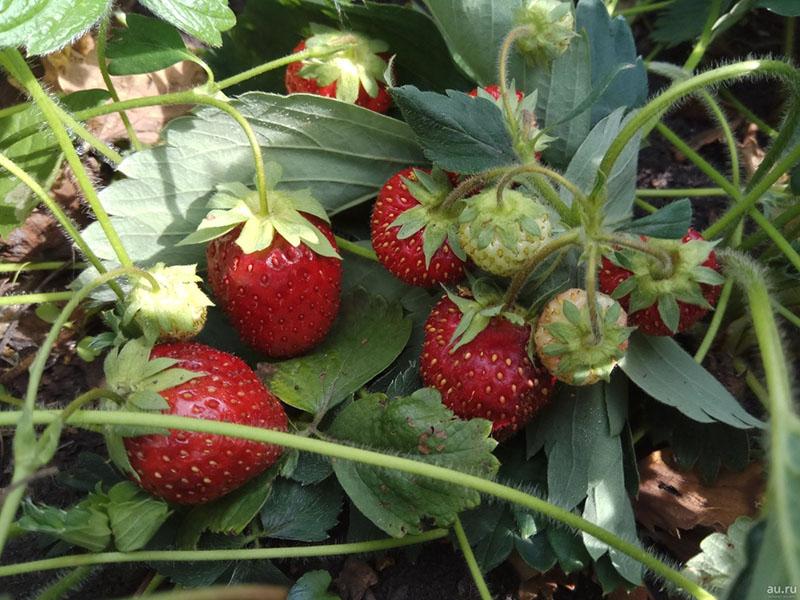Are the Zenga Zengana strawberries remontant or not?
 Selective breeding of the variety took place in Germany in 1954. Are the Zenga Zengana strawberries remontant or not? This variety quickly gained recognition from gardeners due to a number of advantages over its predecessors and remained the most popular variety throughout the second half of the twentieth century. The popularity of the variety began to decline with the advent of strawberry repair hybrids, the use of which turned out to be more profitable when growing berries on an industrial scale.
Selective breeding of the variety took place in Germany in 1954. Are the Zenga Zengana strawberries remontant or not? This variety quickly gained recognition from gardeners due to a number of advantages over its predecessors and remained the most popular variety throughout the second half of the twentieth century. The popularity of the variety began to decline with the advent of strawberry repair hybrids, the use of which turned out to be more profitable when growing berries on an industrial scale.
Strawberry "Zenga Zengana": description of the variety

The variety has the following features:
- bushes are erect, compact, not prone to overgrowth;
- foliage is abundant, dark, green;
- leaves of regular shape with jagged edges, the surface is smooth;
- the color of the petals is white, the flowers are located under the leaves;
- berries are conical or heart-shaped, expanding at the stalk;
- berry color - from bright red to burgundy;
- the taste of the fruit is sweet with a slight sourness;
- bushes demonstrate the ability to bear fruit up to 7 years;
- harvesting from one bush - up to 1-1.5 kg;
- the average weight of the first berries is up to 40 g, over time the weight decreases to 10-15 g.
 The variety belongs to the hybrids obtained by crossing Markee and Sieger strawberries. Thanks to its high yield and long-term fruiting, the variety has received recognition from gardeners and remains a worthy competitor to new hybrids.
The variety belongs to the hybrids obtained by crossing Markee and Sieger strawberries. Thanks to its high yield and long-term fruiting, the variety has received recognition from gardeners and remains a worthy competitor to new hybrids.
Depending on the light, the color and healthiness of the strawberry differs. The richer and darker the color, the more light the plant received, and the fruits were filled with vitamins and other useful substances.
Advantages and disadvantages
 The Zenga Zengana strawberry variety is the first developed strawberry variety suitable for deep-freezing.
The Zenga Zengana strawberry variety is the first developed strawberry variety suitable for deep-freezing.
The advantages and disadvantages include:
| Advantages | disadvantages |
| Preservation of shape and structure after heat exposure during cooking or freezing. | Extended ripening period of berries. |
| Resistance to white spot. | Reduction in fruit size towards the end of the fruiting period. |
| Ability to adapt to different types of soil. | The fruits of the bushes of the first year are different from the second years. |
| Resistant to high humidity and long rainy season. | High risk of developing strawberry mites and gray rot. |
| Pronounced taste and aroma with notes of nutmeg. | The berries are tightly attached, for separation you need to cut the fruit along with the stalk. |
| Frost resistance. Resistant to temperatures down to -24 degrees Celsius. |
Despite a number of advantages and a good reputation, Zenga Zengana strawberries do not belong to the repair varieties that can bear fruit up to 3 times during the season. This variety is well suited for private cultivation in small areas.
Strawberry variety "Zenga Zengana": planting
Strawberries are distinguished by convenient methods of vegetative propagation. After purchasing a seedling in a nursery, further cultivation of the culture is available even for novice gardeners and gardeners.
How to choose seedlings
 When buying or choosing seedlings, you need to pay attention to the integrity and overall health of the plant.
When buying or choosing seedlings, you need to pay attention to the integrity and overall health of the plant.
Criterias of choice:
- elasticity, dense core structure;
- basal neck - 6 cm;
- developed root system;
- 5-6 leaves of saturated color on the stem;
- lack of mechanical damage.
It is worth purchasing seedlings only from trusted sellers with a good reputation.
Soil and place on the site

Despite the fact that the Zenga Zengan variety is unpretentious in the choice of soil, the gardener needs to pay attention to a number of criteria that directly affect the speed of adaptation of seedlings on the site:
- Acidic soils have a bad effect on the condition of the berries; to improve the situation when digging, it is necessary to add 300 g of dolomite flour per square meter of beds every 3 years.
- The beds should be well lit by the sun, a flat surface and protection from the wind is encouraged.
- If clay soils are found, sand should be added to loosen it.
- Planting in beds where mustard, garlic, grains or legumes previously grew, carrot Is the best option. Potatoes, cucumbers, tomatoes, and berry bushes are considered undesirable precursors for strawberries.
- The depth of groundwater is at least 60 cm.
If planting begins in early spring, soil preparation can be carried out in the fall.
Digging, fertilizing and processing the beds is carried out 3 weeks before planting.
Zenga Zengana strawberry planting rules
 Planting of this variety of strawberries is carried out in autumn or spring when the temperature of the soil layer reaches at least +15 degrees Celsius.
Planting of this variety of strawberries is carried out in autumn or spring when the temperature of the soil layer reaches at least +15 degrees Celsius.
Planting stages:
- Prepare small depressions in the soil (up to 15 cm) at a distance of 20-30 cm from each other. The spaces between the rows are 30-60 cm.
- Moisten the soil.
- Place the seedlings and cover with earth so that the rosette remains on the surface.
- Water each bush (500-1000 ml of water).
- After moisture penetration into the soil, cover the surrounding area with a small layer of hay or sawdust (no more than 7 cm).
Landing takes place in the evening.
Care of the Zenga Zengana strawberry variety
 After planting is complete, the gardener has to look after the crop and wait for the sweet strawberry fruits to appear.
After planting is complete, the gardener has to look after the crop and wait for the sweet strawberry fruits to appear.
Watering
 Strawberries do not tolerate drought and need timely soil moisture in the absence of precipitation. The most suitable is the morning, drip irrigation every three days.
Strawberries do not tolerate drought and need timely soil moisture in the absence of precipitation. The most suitable is the morning, drip irrigation every three days.
Top dressing
 In the case of growing strawberries of the Zenga Zengane variety, the gardener must observe the exact dosage when applying mineral fertilizers.
In the case of growing strawberries of the Zenga Zengane variety, the gardener must observe the exact dosage when applying mineral fertilizers.
Features of feeding:
- after the appearance of the first shoots of the garden, it is necessary to water with a solution of mullein and water in a ratio of 1 to 4 at the rate of 10 liters per 1 square meter;
- before flowering, each bush must be fertilized with 500 ml of nutrient solution (1 teaspoon of potassium sulfate, 2 tablespoons of nitroammofoska per 10 liters of water);
- after the end of the fruiting period, each square meter of the beds must be watered with a solution of 100 g of ash diluted in 10 liters of water.
In autumn the soil is enriched mullein at the rate of 3 kg of dry weight per 1 square meter.
Disease prevention

The most dangerous pests for strawberries are:
- powdery mildew;
- brown spotting;
- nematodes;
- gray rot;
- strawberry mites.
To protect the berries, you need to monitor the condition of all crops on the site. In addition, you need:
- Timely loosen the soil.
- Choose healthy seedlings, disinfect the root system.
- Avoid waterlogging and stagnation of liquid in the root area.
- Identify and remove diseased bushes.
- Treat with fungicides.
- Observe the rules of crop rotation.
Fighting plant diseases on the site can take a lot of time, which is why the gardener needs to prevent a disease or pest colony that has not yet developed.
Preparing for winter
 Despite the excellent frost resistance, strawberries must be protected from possible soil freezing and temperature changes. Zenga Zengana strawberries are not remontant, so after harvesting the gardener can start thinking about the next season.
Despite the excellent frost resistance, strawberries must be protected from possible soil freezing and temperature changes. Zenga Zengana strawberries are not remontant, so after harvesting the gardener can start thinking about the next season.
Before wintering, you must:
- Remove dead plant parts.
- Form a small earthen mound near each bush.
- Cover the beds before the onset of the first frost. There should be a small cushion of air between the soil and the cover.
 For warm regions, a layer of peat or straw mulch is suitable; in cold areas, a shelter should be formed from frame arches and spunbond or agrofibre.
For warm regions, a layer of peat or straw mulch is suitable; in cold areas, a shelter should be formed from frame arches and spunbond or agrofibre.
To prevent decay of the root system, planting must be freed from the shelter at the beginning of active snow melting.